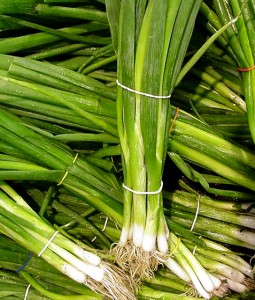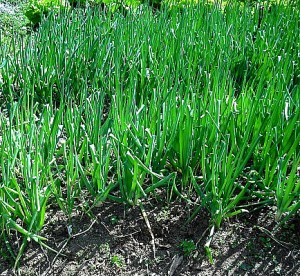 Green Onion or Leek are also known as spring onion, salad onion or onion sticks in many countries. It is an edible plant of the genus Allium. The upper green portion of the onion have achieved the dark hue that indicates a desirable level of flavor while still retaining a tender texture. It lacks a fully developed root bulb.
Green Onion or Leek are also known as spring onion, salad onion or onion sticks in many countries. It is an edible plant of the genus Allium. The upper green portion of the onion have achieved the dark hue that indicates a desirable level of flavor while still retaining a tender texture. It lacks a fully developed root bulb.
One of the great things about green onions is that they are often available year round. With a taste and texture that is different from a mature onion, the spring onion can be served in a number of different ways. They may be cooked or used raw as a part of salads or Asian recipes. Diced green onions are used in soup, noodle and seafood dishes, as well as sandwiches, curries or as part of a stir fry. Best of all, green onions tend to be very inexpensive and widely available at most supermarkets.
Choosing the best quality of green onions is not difficult. When shopping, make sure the small root on the onion plant is white and relatively firm. The green tops should be crisp and show little to no wilting. Keep in mind that it is best to purchase green onions shortly before use, as the onions will usually begin to wilt within a day or two. Placing the green onions in a tightly sealed plastic bag can slow this process. Store the bag in the vegetable crisper compartment of the refrigerator. Generally, this will allow the green onions to remain usable for up to five days.
In addition to being flavorful, green onions offer many health benefits, and regular consumption of green onions has been shown to:
- Lower blood sugar
- Decrease high cholesterol and blood pressure levels
- Reduce the risk of developing colon and other cancers
- Reduce inflammation
Green onions are rich in vitamin C which not only boosts immunity, but offers protection from cardiovascular disease, eye disease, and skin wrinkling. Other nutrients found in green onions include fiber, manganese, vitamin B6, potassium, and copper.
Production of Green Onion or Leek
Varieties:
- Large Long Summer – Very early maturity 4 months from transplant foliage is medium green, shanks length 20 to 25 cm, diameter 2.3 to 3 cm. widely adapted, very fast growing.
- Others: Carentan, American Flag
Soil Requirements
Green onions is not exacting in its soil requirements. It grows in sandy loam to heavy clay soils. Better crop is obtainable in a sandy loam that is rich in humus and plant nutrients. Soil of medium acidity is preferable for growing the crop. The field must have adequate drainage. Green onions are commonly planted in any season the year, the plants thrive best from August to March.
Land Preparation
The land is plowed and harrowed several times until the soil is brought to a fine tilth. Multiple rows are prepared. Generally, two to three rows make up a multiple row. Distance between rows is 30 to 40 cm.
Propagation
By seed or transplant. A hectare of land requires 2 to 3 k. of seeds. The seeds are sown in seed boxes or seedbeds containing sterilized soil. The seeds are sown thinly down to 2 cm. deep and 8 cm. apart in the rows of a seed box or seedbed. Seedlings are ready for transplanting 40 to 70 days from sowing.
Planting and Spacing
Direct seedling is done by drilling the seeds thinly along the rows. Seeds are covered with the fine soil up to a depth of 1 cm. Seedlings are then thinned to have a spacing of about 20 cm. between plants.

Cultivation, Irrigation and Weeding
Cultivation, irrigation and weeding is done in the same manner for all methods of planting. As the plant develop, the soil is ridged towards the base. Two or four ridging are considered enough to provide the plants with the necessary cultivation, weeding and blanching for the development of long, tender stems of leaf sheaths. The interval of irrigating the plants depends largely upon the weather and soil conditions in the locality. In using mulch, cultivation and weeding are not very necessary. Irrigate when the soil begins to crack. Under normal conditions only one irrigation is needed.
Fertilizer Application
Liberal applications of fertilizer should be practiced. Apply about 10 tons of chicken manure per hectare. This is supplemented with the application of nitrogenous fertilizers such as ammonium sulfate at the rate of about 100 to 150 kg. per ha. If commercial fertilizers are to be used alone, 250 to 300 kg of fertilizer 12-24-12 mixture per ha. is applied during the preparation of the land. To get maximum yield, about 100 to 150 kg. per ha. of ammonium sulfate or its equivalent from other nitrogenous fertilizers are side dressed at banking time.
Control of Pests and Diseases
Pests and diseases of green onion are the same as those that attack bulb onion.
Harvesting and Handling
Maturity of GREEN Co. varieties are early. It ranges from 4 months from transplant to medium late depending on the variety.
Source: Cultural Directions for Phil. Agricultural Crop, Wikipedia.com, wisegeek.com; Photo: food-facts.suite101.com